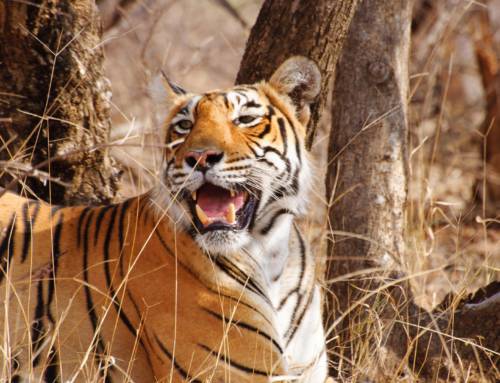Blog Author: Aishwarya Anilkumar
Key highlights
- Tiger Reserves (TRs) are bestowed with the highest levels of protection under the protected areas network and are governed by the ‘umbrella species’ concept of conservation management.
- A scientific assessment of the vegetation conditions was carried out in TRs distributed across 18 states of India.
- The study finds extensive browning and drying of vegetation in over 50% of the 29 TRs assessed.
- The results suggest that the enhanced protection status of TRs alone is insufficient in preserving the vegetation and safeguarding the long-term viability of tiger habitats.
Top carnivores like lions, tigers, or other charismatic large mammals like elephants are considered ‘umbrella species’ with an idea that protecting their habitat will eventually lead to the conservation of many other species within the habitat itself. Tiger Reserves (TRs) are bestowed with the highest levels of protection under the protected areas network and are governed by the ‘umbrella species’ concept of conservation management. The habitat’s vegetation conditions play a crucial role in such conservation strategies.
Scientists, Pradeep S Kougli and Dr. Krithi K Karanth from the Centre for Wildlife Studies and Nicholas Clinton from Google Inc. conducted a scientific assessment of the vegetation conditions in TRs distributed across 18 Indian states. These TRs represent the variety of habitats in which tigers can be found. As a result, the study sites included unique landscapes such as India’s subtropical evergreen and moist deciduous forests of the Western Ghats and North-Eastern hills, dry deciduous and scrub forests of the Central Indian highlands, deciduous forests of the Western and Central Himalayan foothills, and mangroves of the Gangetic delta.
The researchers selected 29 TRs, declared in the year 2000 or earlier, and also matched each TR with a Wildlife Sanctuary (WLS) in the same state as the TR to compare the levels of protection vis-à-vis the quality of the vegetation. Satellite imagery was used to measure the extensive browning and drying of forest vegetation. The study found extensive browning and drying of vegetation in more than half of the 29 TRs assessed. In terms of vegetation, less than 50% TRs fared better than the WLSs to which they were compared.
The results of this pivotal study suggest that the elevated protection status of the TRs alone is not enough to preserve the vegetation condition and safeguard the long-term viability of tiger habitats. The study also recommends additional research to better explain these patterns and understand their drivers so that TRs can be designated and managed efficiently. Research like this helps us understand the importance of good vegetation conditions in TRs, which further helps provides quality habitat for other species under the umbrella species concept. This brings a vegetation condition perspective in the protected areas and also highlights the significance of evaluating the quality of the forest vegetation.
Keywords: Protected Areas, Tiger Reserves, Forest Vegetation, Umbrella Species, Conservation.
You can access the original article here.



